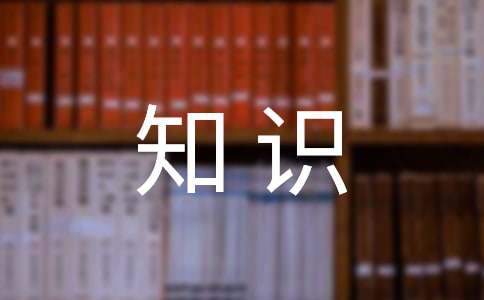- 相关推荐
小学生最基础的英语知识
小学的英语知识注重的是基础,对于英语的从句和其他进阶要求不高,因此,小学生下哟了解最基础的英语知识,下面是小编归纳的一般现在时基本用法介绍 一般现在时的功能,希望对童鞋们有所帮助。

1.表示事物或人物的特征、状态。如:The sky is blue.天空是蓝色的。
2.表示经常性或习惯性的动作。如:I get up at six every day.我每天六点起床。
3.表示客观现实。如:The earth goes around the sun.地球绕着太阳转。
一般现在时的构成:1. be动词:主语+be(am, is, are)+其它。如:I am a boy.我是一个男孩。
注意:(我用am,你用are,三单is,复数are。)
行为动词:
主语+行为动词(+其它)
如:We study English.我们学习英语。
注意:(当主语为第三人称单数(he, she,it)时,要在动词后加"-s"或"-es"。如:Mary likes Chinese.玛丽喜欢汉语。)
一般现在时的变化:
1. be动词的变化。
肯定句:主语+be+其它
He is a worker. 他是工人。
否定句:主语+ be + not +其它。
He is not a worker.他不是工人。
一般疑问句:Be +主语+其它。
(be动词移到句首)
如:I am a student.
-Are you a student?
-Yes. I am. / No, I'm not.
特殊疑问句:疑问词+一般疑问句。
如:My bike is under the tree.
Is your bike under the tree?
Where is your bike?
2.行为动词的变化。
肯定句:主语+动词原形(+其它)。
否定句:主语+ don't( doesn't ) +动词原形(+其它)。
如:I like bread. I don't like bread.
当主语为第三人称单数时,要用doesn't构成否定句。
如:He ofter plays football.
He doesn't often play football.
一般疑问句:Do( Does ) +主语+动词原形+其它。(句首加助动词do, does)
如:I often play football.
- Do you often play football?
- Yes, I do. / No, I don't.
当主语为第三人称单数时,要用does构成一般疑问句。
如:She goes to school by bike.
- Does she go to school by bike?
- Yes, she does. / No, she doesn't.
特殊疑问句:疑问词+一般疑问句。
如:She goes to school by bike.
Does she go to school by bike?
How does she go to school?
动词+s的变化规则
1.一般情况下,直接加-s,如:cook-cooks, milk-milks
2.以s. x. sh. ch. o结尾,加-es,如:guess-guesses, wash-washes, watch-watches, go-goes
3.以“辅音字母+y”结尾,变y为i, 再加-es,如:study-studies
现在进行时
1.现在进行时表示现在正在进行或发生的动作,也可表示当前一段时间内的活动或现阶段正在进行的动作。(句中一般含有now, look, listen.)
2.现在进行时的肯定句基本结构为be+动词ing.
如:Tom is reading books in his study .
3.现在进行时的否定句在be后加not。
如:Tom is reading books in his study .
Tom is not reading books in his study .
4.现在进行时的一般疑问句把be动词调到句首。
如:Tom is reading books in his study .
Is Tom reading books in his study ?
5.现在进行时的特殊疑问的基本结构为:疑问词+一般疑问句?
(注意:当划线部分包含谓语动词时,用疑问词代替划线部分放到句首,原划线处应加上doing)
如:Tom is reading books in his study .
Tom is reading books in his study .
Is Tom reading books in his study ?
Is Tom reading books in his study ?
What is Tom doing in his study?
Where is Tom reading books?
动词加ing的变化规则
1.一般情况下,直接加ing,如:cook-cooking
2.以不发音的e结尾,去e加ing,如:make-making, taste-tasting
3.如果末尾是辅音字母加一个元音字母和一个辅音字母,双写末尾的辅音字母,再加ing,如:run-running, stop-stopping
【小学生最基础的英语知识】相关文章:
小升初英语基础知识汇总10-13
英语基础知识短语辨析训练及答案10-14
域名的基础知识06-16
显卡基础知识07-19
Java基础知识精选09-07
cpu基础知识10-09
插花的基础知识10-22
Photoshop的基础知识09-21
《基金基础知识》常见知识考点08-30